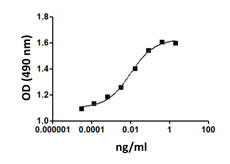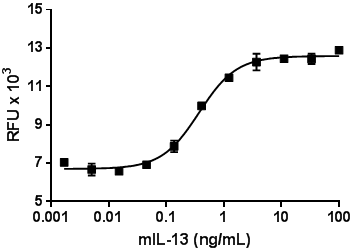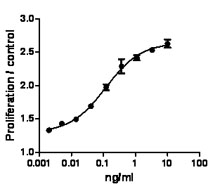- Regulatory Status
- RUO
- Other Names
- Granulocyte colony stimulating factor, CSF3, CSFG, MGI-IG
- Ave. Rating
- Submit a Review
- Product Citations
- publications
| Cat # | Size | Price | Save |
|---|---|---|---|
| 713502 | 10 µg | ¥50,350 |
This product is not available for shipping outside of the United States.
G-CSF is the key hematopoietic cytokine involved in the control of neutrophil development; therefore, it is a critical regulator of innate immunity against bacterial infections. G-CSF mobilizes stem cells indirectly by downregulating the expression of CXCL12 on marrow osteoblasts and by releasing neutrophil and monocyte proteolytic enzymes, including neutrophil elastase, cathepsin G, and matrix metalloproteinase-9. This in turn degrades important HSC-trafficking and adhesion molecules, such as c-kit, VCAM-1, and CXCR4. In addition, G-CSF possesses immunosuppressive effects on monocytes/macrophages, dendritic cells, and T lymphocytes. The receptor for G-CSF is expressed not only in hematopoietic cells but also in cardiomyocytes, skeletal muscle, and neurons. G-CSF influences mouse skeletal muscle development and regeneration by stimulating myoblast proliferation. In vitro, G-CSF displays strong antiapoptotic activity in neuronal cells.
Product DetailsProduct Details
- Source
- Mouse G-CSF, amino acids Val31-Ala208 (Accession# NM_009971), was expressed in E. coli.
- Molecular Mass
- The 179 amino acid N-terminal methionylated recombinant protein has a predicted molecular mass of approximately 19 kD. The predicted N-terminal amino acid is Met.
- Purity
- >98%, as determined by Coomassie stained SDS-PAGE and HPLC analysis.
- Formulation
- Lyophilized, carrier-free.
- Endotoxin Level
- Less than 0.1 ng per µg of protein.
- Storage & Handling
- Unopened vial can be stored at -20°C or -70°C. For maximum results, quick spin vial prior to opening. Reconstitute in water to a concentration of 0.1-1.0 mg/ml. Do not vortex. It is recommended to further dilute in a buffer, such as 5% Trehalose, and store working aliquots at -20°C to -80°C. Avoid repeated freeze/thaw cycles.
- Activity
- ED50 ≤ 0.05 ng/ml, corresponding to a specific activity of ≥ 2.0 x 107 units/mg as determined by a cell proliferation assay using mouse NFS-60 cells.
- Application
-
Bioassay
- Product Citations
-
Antigen Details
- Structure
- Cytokine
- Distribution
-
Monocytes, mesothelial cells, fibroblasts, endothelial cells, and neurons.
- Function
- G-CSF acts on myeloid progenitor cells to stimulate survival, proliferation, and neutrophilic maturation. On mature neutrophils, G-CSF enhances survival, superoxide anion and alkaline phosphatase production, arachidonic acid release, and antibody dependent cellular cytotoxicity.
- Interaction
- Hematopoietic progenitor cells, neutrophils, monocytes, platelets, endothelial cells, trophoblastic cells, myoblasts, cardiomyocytes, cardiac fibroblasts, neurons, and some small cell lung carcinoma cell lines.
- Ligand/Receptor
- CD114 (G-CSFR)
- Bioactivity
- Stimulation of mouse NFS-60 cells.
- Cell Type
- Embryonic Stem Cells, Hematopoietic stem and progenitors
- Biology Area
- Cell Biology, Stem Cells
- Molecular Family
- Cytokines/Chemokines, Growth Factors
- Antigen References
-
1. Kim HK, et al. 2006. Blood 108:812.
2. Donahue RE, et al. 2009. Blood 114:2530.
3. Shimoji K, et al. 2010. Cell. Stem. Cell. 6:227.
4. Martins A, et al. 2010. IUBMB Life 62:611.
5. Hara M, et al. 2011. J. Exp. Med. 208:715. - Gene ID
- 12985 View all products for this Gene ID
- UniProt
- View information about G-CSF on UniProt.org
Related FAQs
- Why choose BioLegend recombinant proteins?
-
• Each lot of product is quality-tested for bioactivity as indicated on the data sheet.
• Greater than 95% Purity or higher, tested on every lot of product.
• 100% Satisfaction Guarantee for quality performance, stability, and consistency.
• Ready-to-use liquid format saves time and reduces challenges associated with reconstitution.
• Bulk and customization available. Contact us.
• Learn more about our Recombinant Proteins. - How does the activity of your recombinant proteins compare to competitors?
-
We quality control each and every lot of recombinant protein. Not only do we check its bioactivity, but we also compare it against other commercially available recombinant proteins. We make sure each recombinant protein’s activity is at least as good as or better than the competition’s. In order to provide you with the best possible product, we ensure that our testing process is rigorous and thorough. If you’re curious and eager to make the switch to BioLegend recombinants, contact your sales representative today!
- What is the specific activity or ED50 of my recombinant protein?
-
The specific activity range of the protein is indicated on the product datasheets. Because the exact activity values on a per unit basis can largely fluctuate depending on a number of factors, including the nature of the assay, cell density, age of cells/passage number, culture media used, and end user technique, the specific activity is best defined as a range and we guarantee the specific activity of all our lots will be within the range indicated on the datasheet. Please note this only applies to recombinants labeled for use in bioassays. ELISA standard recombinant proteins are not recommended for bioassay usage as they are not tested for these applications.
- Have your recombinants been tested for stability?
-
Our testing shows that the recombinant proteins are able to withstand room temperature for a week without losing activity. In addition the recombinant proteins were also found to withstand four cycles of freeze and thaw without losing activity.
- Does specific activity of a recombinant protein vary between lots?
-
Specific activity will vary for each lot and for the type of experiment that is done to validate it, but all passed lots will have activity within the established ED50 range for the product and we guarantee that our products will have lot-to-lot consistency. Please conduct an experiment-specific validation to find the optimal ED50 for your system.
- How do you convert activity as an ED50 in ng/ml to a specific activity in Units/mg?
-
Use formula Specific activity (Units/mg) = 10^6/ ED50 (ng/mL)












Follow Us